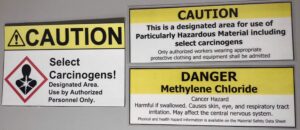Chloroform, Dichloromethane, and Other Halogenated Organic Compounds
[et_pb_section fb_built=”1″ admin_label=”section” _builder_version=”3.0.47″][et_pb_row make_fullwidth=”on” _builder_version=”3.0.51″][et_pb_column type=”4_4″ _builder_version=”3.0.51″ parallax=”off” parallax_method=”on”][et_pb_image src=”https://safe.engineering.asu.edu/wp-content/uploads/sites/77/2023/10/halogenated-organics1-scaled-1.jpg” _builder_version=”3.0.51″][/et_pb_image][/et_pb_column][/et_pb_row][et_pb_row admin_label=”row” _builder_version=”3.0.47″ background_size=”initial” background_position=”top_left” background_repeat=”repeat”][et_pb_column type=”1_2″ _builder_version=”3.0.47″ parallax=”off” parallax_method=”on”][et_pb_blurb title=”Chloroform is a common solvent, starting with NMR samples in sophomore-level chemistry. Why should I worry?” admin_label=”Blurb” _builder_version=”3.0.51″ header_font=”|on|||” header_font_size=”20px”]
Chloroform, dichloromethane, and many other halogenated organic compounds readily pass through nitrile gloves. This means that the disposable gloves most people wear every day in laboratories provide no protection from chloroform and dichloromethane, and small splashes can result in exposure. Exposure must be avoided because these chemicals are known or suspected carcinogens and teratogens.
The interaction of some halogenated organics with different glove polymers is shown below on glove manufacturer’s chemical compatibility charts.

Chloroform Standard Operating Procedure (SOP)
Dichloromethane Standard Operating Procedure (SOP)
Carbon Tetrachloride Standard Operating Procedure (SOP)
Working with Thick Gloves Guide
Carcinogen Use Area Signage (contact [email protected] or [email protected] for laminated signs)
[/et_pb_blurb][/et_pb_column][et_pb_column type=”1_4″ _builder_version=”3.0.47″ parallax=”off” parallax_method=”on”][et_pb_blurb title=”Other Resources” admin_label=”Blurb” _builder_version=”3.0.51″ header_font=”|on|||” header_font_size=”20px”]
Halogenated Organic Compounds – NOAA
OSHA-Regulated Carcinogens (the “OSHA Thirteen”) – OSHA
[/et_pb_blurb][/et_pb_column][/et_pb_row][et_pb_row _builder_version=”3.0.51″][et_pb_column type=”1_2″ _builder_version=”3.0.51″ parallax=”off” parallax_method=”on”][et_pb_blurb _builder_version=”3.0.51″]

Polyvinyl alcohol (PVA) gloves provide good protection, but their thickness can make some lab techniques difficult. The “Working with Thick Gloves” guide illustrates how to incorporate PVA gloves into chemical handling while maintaining manual dexterity.
Ensure a written SOP is in place, and appropriate engineering controls & PPE (including compatible gloves) are available, before using any of the following halogenated organic compounds:
- 1-chloronaphthalene (CAS# 90-13-1)
- 2-chlorotoluene (CAS# 95-49-8)
- 4-chlorotoluene (CAS# 106-43-4)
- 1,2-dibromo-3-chloropropane (CAS# 96-12-8)
- 3,3′-dichlorobenzidine (CAS# 91-94-1)
- 1,2-dichloroethane, also called ethylene dichloride or EDC (CAS# 107-06-2)
- benzoyl chloride (CAS# 98-88-4)
- bis-chloromethyl ether (CAS# 542-88-1)
- carbon tetrachloride (CAS# 56-23-5)
- chlorobenzene (CAS# 108-90-7)
- chloroform (CAS# 67-66-3)
- dichloromethane, also called methylene chloride (CAS# 75-09-2)
- epichlorohydrin (CAS# 106-89-8)
- methyl chloromethyl ether (CAS# 107-30-2)
- perchloroethylene, also called PERC (CAS# 127-18-4)
- trichloroethylene (CAS# 79-01-6)
- vinyl chloride (CAS# 75-01-4)
[/et_pb_blurb][/et_pb_column][et_pb_column type=”1_2″ _builder_version=”3.0.51″ parallax=”off” parallax_method=”on”][et_pb_blurb _builder_version=”3.0.51″]
Dichloromethane is included with the following chlorinated compounds among the OSHA-regulated carcinogens.
| dichloromethane or methylene chloride | methyl chloromethyl ether | 3,3′-dichlorobenzidene (and its salts) |
| bis-chloromethyl ether | vinyl chloride | 1,2-dibromo-3-chloropropane |
In addition to the SOP, appropriate engineering controls, and PPE, OSHA-regulated carcinogens also require signage on every door or entry to the area of the lab where the chemical(s) will be stored and used. The signage must include the following wording:
DANGER
(CHEMICAL IDENTIFICATION)
MAY CAUSE CANCER
AUTHORIZED PERSONNEL ONLY
[/et_pb_blurb][/et_pb_column][/et_pb_row][/et_pb_section]
